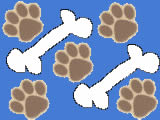The Use Of Motivation In Dog Training
The Two Goals In Life Are To Receive Reward And Avoid Discouragement
|
That means if a positive result occurs after a behavior, that behavior is likely to occur again. If something bad or negative happens after a behavior, the chance of it occurring again will be less. The students are motivated to do something or refrain from doing something. Motivation is the single most important factor in dog training, in that what motivates a dog is a large factor in the dog's emotional state. There are two main reasons for motivation. Either the desire to receive a reward or the desire to avoid the punishment. Just as we would work harder to receive a larger paycheck, we would leave a movie theatre very quickly in the event of a fire. We are very motivated in each case to achieve a goal; our dogs are capable of similar reasoning. . |
If we are to use the reward as the motivator we need to be sure that the reward we are offering is what the dog finds valuable. The stronger the dog desires the reward, the more effective it becomes in training. Basically there are a few ways to increase the desire of something and that is to first select the reward that the dog finds most attractive; chasing or pulling on his favorite ball or toy, or a tasty liver treat as opposed to his regular food. Then temporarily deprive the dog of the need to which the reward applies; either by withholding food for a period of time or temporarily confine the dog in an isolated spot. Then save the reward for those times when your dog has really earned it. In another words, if our dog receives treats or toys all the time, why do they need to work for them? Remember, our dog will not normally volunteer to listen to us since most of the time what we want the dog to do is in conflict with what they want to do. |
|
|
The rewards that are most often used are praise, play, and food. Praise would include soft, high tones or words, a smile, a relaxed body gesture, a pat, a rub, a scratch on the head or chest, or a hug. Play would include a dance of joy, running and chasing a stick or Frisbee, romping, swimming or playing. It is important that all of these be done with their master. Food has different levels of effectiveness, in that a piece of broiled liver is tastier than a stale dry kibble. |
Continue to Punishment In Dog Training









